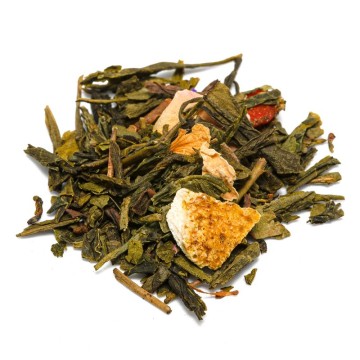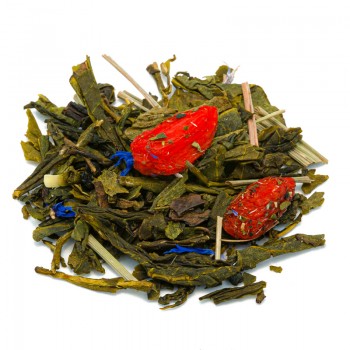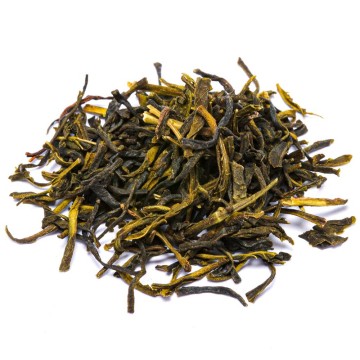Green tea Goji berries and Mandarin
A true mix of taste and well-being. Sweet but at the same time fresh, thanks to the combination of citrus fruits. In addition to being an excellent tea to drink throughout the day, it also has beneficial effects on the body. It gives a diuretic effect obtained through green tea, while goji berries have an anti-aging and antioxidant effect, enhanced in this tea rich in vitamin C. This fabulous combination of green tea with goji and mandarin, releases the sweet aroma of berries in harmony with soft green tea. It is a drink with a delicate but fresh taste, due to the presence of mandarins and orange peel. Ideal to quench your thirst and acquire all the beneficial qualities of citrus fruits, goji and antioxidant tea par excellence.
Properties and benefits
This infusion helps to favor our body through the assimilation of various nutrients and substances useful for well-being. First of all, it aids in proper digestion and intestinal health thanks to the presence of fermented tea leaves and goji berries, rich in antioxidants. The bitter components of green tea help stimulate gastric juices and facilitate digestion. A combination that is also useful for stimulating diuresis and purifying the body. Green tea gives its probiotic properties during digestion, thanks to the tea leaves which contain beneficial bacteria. We now know that the gut is an important component of the immune system, and these beneficial bacteria work to restore balance. When the intestines are functioning well, the side effects of the imbalance such as bloating and intestinal gas are avoided. For the well-being of the digestive system, citrus fruits also help as factors for gastro-intestinal distension, calming the effects of nausea and indigestion. Green tea also has anti-aging benefits, and contains an abundant amount of catechin, with powerful antioxidant activity. Goji berries are considered a valuable fruit, as they are a rich source of amino acids, antioxidants and vitamins. Excellent substances for the immune defense of our body, vitamins A and C help fight the damage of free radicals on cells, maintaining their proper functioning. Dried goji berries are another essential element of this infusion, because they represent a source of precious elements. These berries are a traditional Chinese food and a herbal medicine historically used for the treatment of various diseases. Berries have been studied in modern times for their antioxidant qualities, which are positive for helping the body prevent aging, for neuroprotection and for sugar metabolism. Its rich phytochemical content includes antioxidant phenolic compounds, formerly used to treat fatigue and headaches, and often praised as anti-aging factors. Goji berries also give precious qualities for those who want to improve the immune system, as they contain a high content of ascorbic acid and provitamin A. The fruits are rich in carotenoids, responsible for their red-orange color, such as zeaxanthin and beta-carotene. . Zeaxanthin is one of only two carotenoids that accumulate in the macula lutea of the human eye, with beneficial properties or on ocular tissues. In addition, ascorbic acid helps the well-being of the skin. The addition of mandarin and orange peel enhances the active ingredients with the contribution of vitamin C, antioxidant flavonoids. The vitamin C content stimulates the release of substances beneficial for the skin, such as collagen and elastin, and strengthens the immune system. This herbal tea also provides minerals such as iron, which promotes the regular production of hemoglobin, responsible for the distribution of oxygen to the tissues. The bitter taste of green tea pairs well with sweet nuts such as goji berries, mandarin and orange peel. The citrus flavor and aroma is refreshing, while the goji berries add a sweet fruit taste. As they are immersed in the tea, these ingredients release their sweetness.
Origins and History of cultivation
The tea comes from the Camellia sinensis plant, native to East Asia, the Indian subcontinent and Southeast Asia. The Chinese province of Yunnan is thought to have one of the oldest tea plants in the world, which according to several scholars is over 3,000 years old. When harvested, green tea is immediately placed in the sun or steamed to avoid fermentation. This process preserves the green color of the tea leaves, during the lamination and drying process. Furthermore, compared to aOther types of tea preserve natural phenolic compounds (including catechins) which provide anti-aging benefits - up to 31% of the weight of the dry leaf is present. There is a famous book by Lu Yu, the 8th century AD Tea Sage, in which every aspect of tea was studied. He was described as a medicine for fever, weakness, headache, joint pain and dry eyes. The different types of water used for the preparation were also examined. One difference with black tea is that green tea can be steeped several times. Via the Silk Road, which connected the eastern to the western world, caravans transported silk, tea and other valuable goods from east to west. It was initially a luxury item reserved for wealthier Europeans, and was used as a medicine along with ginger and onion to treat some ailments - mainly gastrointestinal. If at first the transport of tea buds out of China was strictly forbidden, in the mid-nineteenth century it was possible to spread the tea plant and culture. This blend also features another essential ingredient in many infusions, Goji berries. They come from the Lycium barbarum and Lycium chinense Miller plants, closely related. In particular, Lycium barbarum grows and is cultivated in the East, particularly in China, Tibet, Mongolia and Eastern Turkmenistan. Provides spicy, bittersweet berries, which are valuable for their taste when not very ripe. Goji berries have historically been used as food and medicinal plants in China and other Asian countries.
Even in Japan, Goji was called "ninja berries" as it endowed warriors with strength and endurance. Ancient Chinese healers learned about its benefits about 5,000 years ago and started growing the plant. It was originally cultivated by monks from Tibet, but soon spread to the gardens of nobles and emperors.
The first written records of Goji fruits date back to around the 5th century AD, with the writings of the Chinese physician and alchemist Tao Hungching. They were associated with enormous longevity - like that of the Chinese Li Qingyun who, according to legend, lived 256 years. The modern history of these berries began thirty years ago when dried goji appeared as a beneficial fruit in many western states. It soon spread among fans of a healthy eating style. The geobotanical origin of Lycium barbarum L. is unknown, as at least 70 species of Lycium grow naturally in the temperate and subtropical regions of North America, South America, Southern Africa, Eurasia and Australia. About 10 species and varieties are known to be good substitutes for oriental Goji berries. The most common name for goji berries is wolf berries and derives from the cine character "gou", related to that of the wolf. The other element of mandarin is always native to Asia, present even before oranges and lemons. It was introduced in Europe in the first half of the nineteenth century and as an ornamental plant, and then it also spread in the consumption of fruits, very sweet and aromatic.
Plant and flowers
Camellia sinensis, known as the tea plant, is a species of evergreen shrub of the Theaceae family. It is a plant widely cultivated in many parts of the world for the production of tea, which is derived from its leaves. It displays serrated leaves and produces small, fragrant white flowers in the fall. The young leaves can be harvested in the spring and dried for tea production. It grows best in a partially shaded location, above moist, acidic soil. Exposure to strong morning sun, which damages flower buds, and cold, dry winds should be avoided. It may grow very tall, but is kept low for manual leaf picking.
Lycium barbarum L. or Goji plant, is a deciduous solanaceae of the Solanaceae family. Its ellipsoid berries show a bright red-orange color and are 1-2 cm long. The fruits are harvested between late summer and autumn, dried in the shade until the skin shrinks and then exposed to the sun. The outer skin becomes dry and hard but the pulp remains soft.
The best known species and varieties are those of Lycium barbarum and Lycium chinense var. potaninii. The mandarin with the botanical name Citrus reticulata is an orange citrus from the Rutaceae family. The plant is known for its relationship with other varieties, which resemble or derive from the original mandarin. It is one of the oldest citrus fruits, the ancestor of many modern hybrid crops (sweet and bitter oranges, grapefruit, lemons, etc.). It grows in tropical and subtropical areas.
Nutritional values of Green Tea Goji Berries and Mandarin
Green tea contains several antioxidants including EGCg (epigallocatechin gallate). In addition, it shows different levels of potassium, zinc, iron, magnesium and manganese. It makes available phytochemicals such as methylxanthines (caffeine, theobromine, theophylline), vitamin C and B vitamins (thiamine, riboflavin, niacin). Goji berries are also a rich source of nutrients including polysaccharides, flavonoids, carotenoids (zeaxanthin), vitamins (vitamin C, B complex and vitamin E), and various minerals (zinc, iron, calcium, selenium and phosphorus). Mandarin and orange peel are rich in vitamin C.
How to prepare Goji Berries and Mandarin Green Tea
The infusion is obtained by placing about 3-5 grams of the blend of green tea, goji berries and mandarin in a cup (250 ml) with water at 80 ° C . Let it steep for 2 to 3 minutes before sipping this green tea. You can enjoy the tea by adding honey or sugar if you wish. You can put it in the fridge to enjoy it cold.
Green tea Goji berries and Mandarin: side effects and contraindications
Green tea can cause some side effects if you don't stick to the recommended doses. The theine (caffeine) content can trigger disturbances if consumed in excessive quantities, causing nervousness, anxiety, insomnia, palpitations. High doses of tea could affect the functioning of the thyroid gland or strain the liver; therefore it is advisable to consult a specialist in case of chronic diseases. Goji berries have been used as food and for herbal medicine for millennia without toxic effects. However, there have been rare reports of possible interactions with specific medications (blood thinners, medications for diabetes or hypertension). It is advisable to consult your doctor if you are being treated with such medicines. In rare cases, these berries can trigger an allergic reaction, especially in people who are allergic to other fruits. In excessive doses this tea could cause an action of raising blood sugar and acidity in the stomach. Caution is advised during pregnancy and lactation.









 No reward points for this product.
No reward points for this product.


![Green tea Jasmine and jasmine [Natura d'Oriente]](https://www.naturadoriente.com/3373-home_default/green-tea-jasmine-and-jasmine-.jpg)


![Ginseng and ginger green tea [Natura d'Oriente]](https://www.naturadoriente.com/3367-home_default/Green-tea-ginseng-ginger.jpg)


![Green tea with orange and grapefruit [Natura d'Oriente]](https://www.naturadoriente.com/3376-home_default/green-tea-with-orange-and-grapefruit.jpg)


![Green Tea Sencha Kombucha [Natura d'Oriente]](https://www.naturadoriente.com/3380-home_default/-green-tea-sencha-kombucha-.jpg)



